See what a day of canning meat is like!
6 a.m.
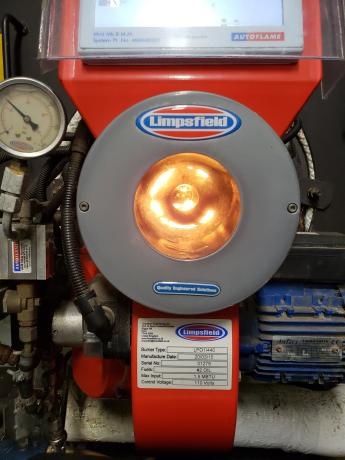
The lights come on and Josh Voth, MCC’s truck driver and canning assistant, fires the boiler for the first day of canning meat at the MCC Central States warehouse in North Newton, Kansas. It’s important to start the boiler early so the steam is hot enough to cook the first batch of meat for the day.
I’m Diana and the East Coast communications coordinator for MCC, but I’m in Kansas this week to show you what a day in the life of canning is like. My hope is that you might decide to volunteer to work on MCC’s canning crew. People in crisis around the world benefit from more than 500,000 cans of meat that the canning crew and more than 30,000 volunteers preserve each year.
MCC needs one more canner, to work from January to May in 2019, and three people to volunteer for a two-year canning term starting in the summer of 2019. (Josh, who works for MCC in Ephrata, Pennsylvania, is just filling in periodically this fall.)
The canning crew is responsible to operate the mobile cannery and safely preserve the meat. Could you be our next canner?
7 a.m.
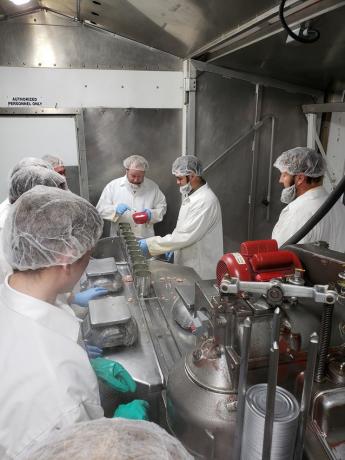
It’s time to begin filling the empty cans with chicken. Volunteers put a teaspoon of salt in each can before filling it with a minimum of 24 ounces of meat and sealing it with a lid. Today’s volunteer groups are from Hutchinson, Kansas, and include people who are Amish and Beachy Amish and those who attend Biblical Mennonite Alliance and Mennonite Church U.S.A. churches.
8 a.m.
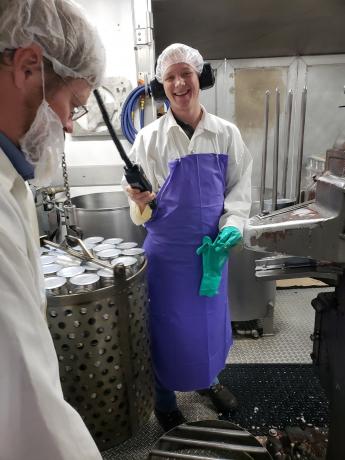
Tristan Pries, from Loma Plata, Paraguay, is one of two canners who are currently part of what is supposed to be a four-person crew. New this year, Tristan says the job is easier than he expected it to be but I can tell he's tired this morning from yesterday's late night last canning. Here, he is using an electric hoist to lift a basket of cans destined for the giant pressure cooker. The cans need to be heated to 246°F for 2 hours and 23 minutes. He’s working with a volunteer from the Newton area.
9 a.m.
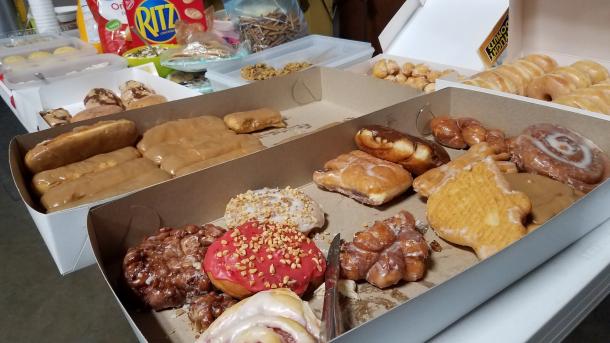
At morning break, volunteers and the canning crew enjoy donuts from Druber’s Donut Shop, a nearby shop in Newton. I overhear the Hutchinson canning committee members discuss where the best place to get a donut is in the area. Some say Newton Donut, others Druber’s. I'm not sure, but the donut I had was just delicious. The volunteers have a break until 9:50 while the meat cooks.
10 a.m.
Michael Doerksen opens the pressure cooker to remove the cans and places them in cooling water. You can tell this is a job he enjoys. He is from Filadelfia, Paraguay, and is back for his second year of meat canning. The pressure is released before opening the cooker, but some steam escapes as the lid is opened. The cans are then cooled for 10-12 minutes.
11 a.m.
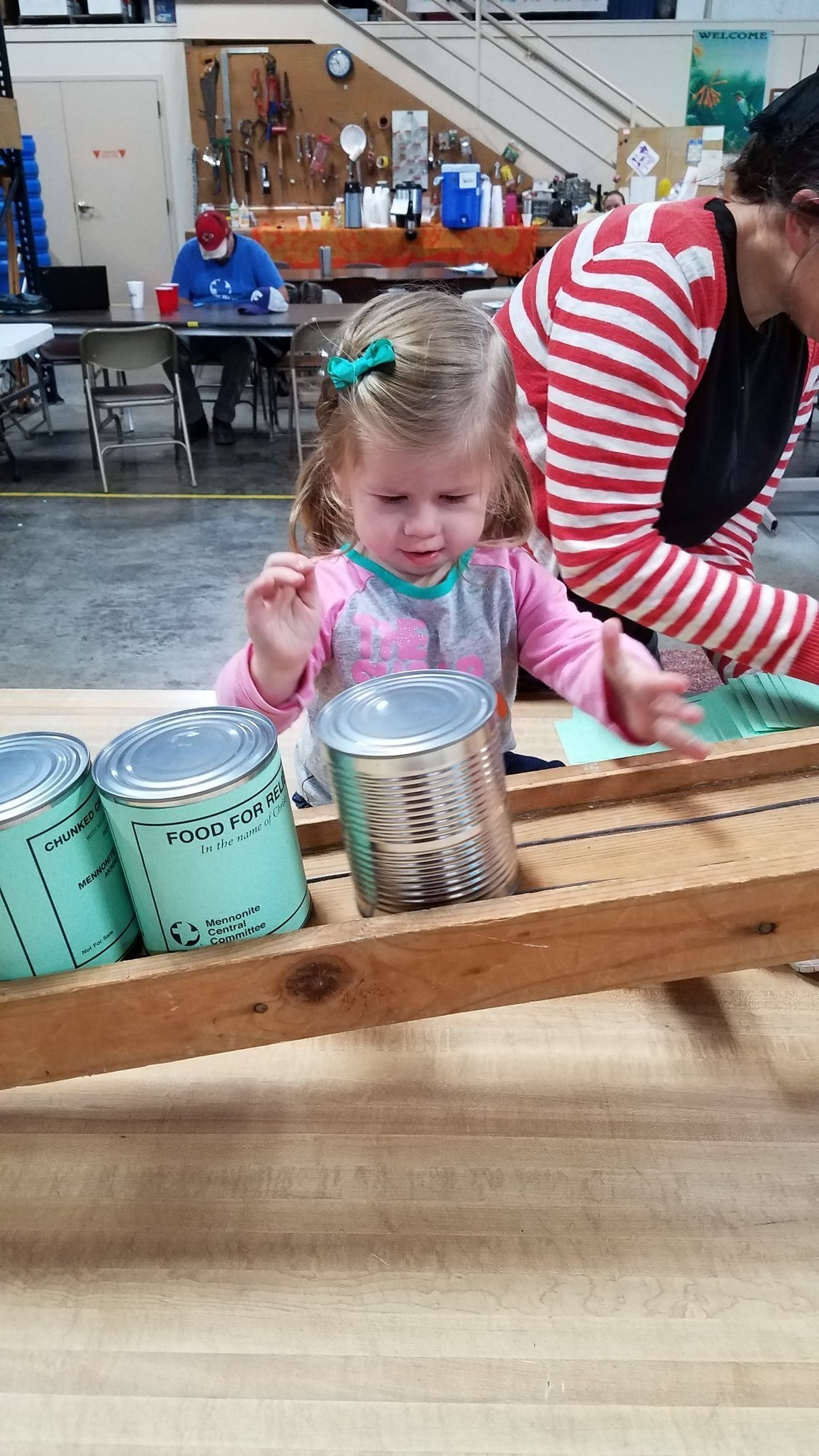
It’s time for wiping down and labeling the cans. Everyone is busy, even adorable Emma Miller, 2, the smallest canning volunteer and daughter of the Hutchinson meat canning committee chair, Aiden Miller.
Everyone can help
It’s a family affair for the Miller family as Aiden, 8, Hudson, 6, Judah, 4, and Emma work together to load cans on the wooden chute to send them to the printer. The children are adorable to watch and it's great that there are jobs for all ages.
Down the chute
Aiden takes his job very seriously and sends the cans through the printer on a conveyor belt. Each can is printed with MCC's unique establishment number, the name of what's in the can (so in this case chicken), the production date and the expiration date. The expiration date is two years from the canning date. It also has a letter signifying where the meat was canned.
12 noon
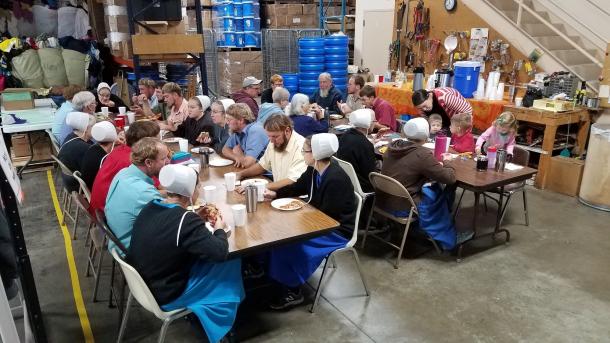
It’s time for lunch! Around 20 pizzas feed the morning shift (pictured) and afternoon shift of volunteers. We barely have enough tables to hold the volunteers! In each shift, there are about 40 volunteers involved in the process. Canning would not happen without all of these volunteers.
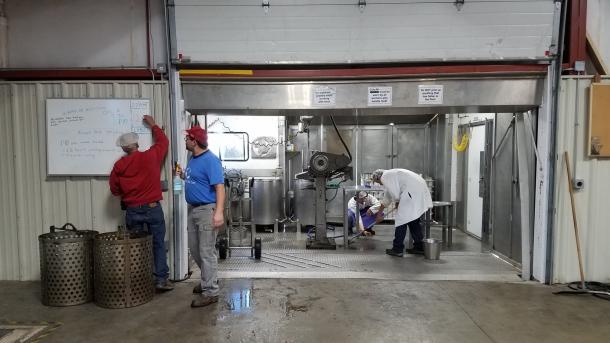
Ken Janzen, a member of the Newton meat canning committee, writes cooking start times up on the whiteboard with the help of Josh while Tristan and another volunteer clean the floor during the lunch break. This mid-day clean-up helps ensure sanitary conditions while canning.
1 p.m.
Grinding chicken
The afternoon crew begins by grinding chicken. Each meat canning committee at the 31 locations the canner usually goes to in the U.S. and Canada choose which meat they want to can. (For this year, some locations have been combined or eliminated from the schedule because the canning crew isn’t full.)
The meat comes in large refrigerated boxes and is always boneless and skinless. In the case of chicken, it needs to be ground for health safety reasons. Grinding chicken is pretty simple. The meat is taken out of a box and put on the table where volunteers feed it into the grinder. The ground chicken then goes directly into a tub and is taken into the mobile meat cannery to be placed in cans.
2 p.m.
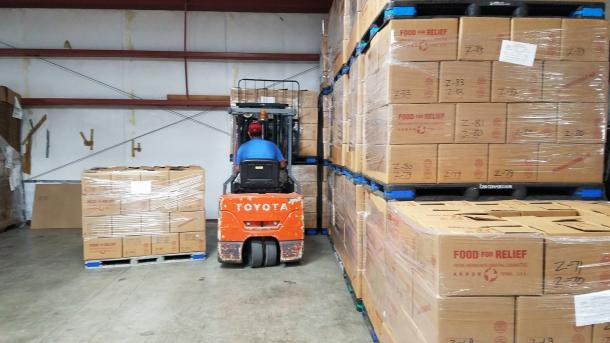
Before break, it’s time to stack the finished and boxed cans of meat in the warehouse. Josh drives the forklift and adds another pallet of canned meat to the growing pile in the MCC Central States warehouse that has been growing after five days of work. In a few months, he’ll pick up these boxes in preparation for shipment from the MCC East Coast Material Resources Center in Ephrata.
3 p.m.

While waiting to label the next batch of cans, women gather in MCC Central States’ workroom and tie comforters, as they chat and laugh together. Comforters provide another way to support MCC’s ministries. Often comforters are sent along with canned meat for distribution.
Sealing
Volunteers are back to work in the mobile cannery – filling, weighing and sealing cans. Michael is running the sealer machine this afternoon making sure every can has a lid properly sealed.
4 p.m.
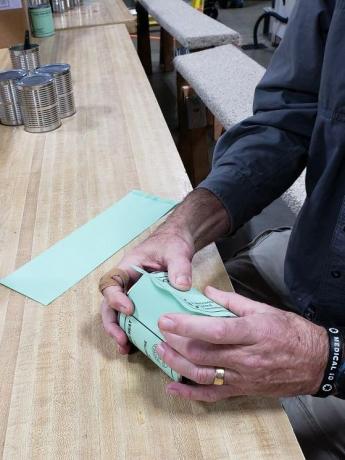
The volunteers are back in the warehouse, labeling cans of chicken. Wallpaper paste is spread on the labels before they are wrapped around the cans. The work is fast because the women are eager to get back to working on the comforters!
5 p.m.
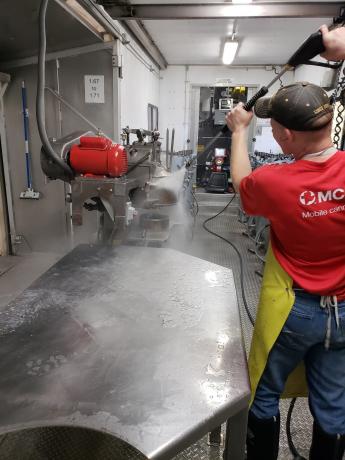
It’s clean-up time, and Michael pressure washes the inside of the mobile meat cannery. This includes the walls, the floor and the tables, making sure everything is spotless to start again tomorrow. I can tell everyone is tired, especially Michael, Tristan and Josh, but the volunteers work hard to finish wiping and labeling the last 1,120 cans.
When the work is done
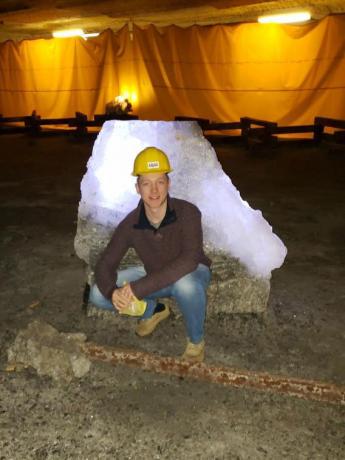
While canning is hard work, it is also a lot of fun as canners travel to new places across the U.S. and Canada. On days off, the canners get to spend time meeting new people, exploring, catching up on sleep and participating in the activities of their host family. In Kansas, the canners visit a zoo and a salt mine, pictured above. After Thanksgiving break it is off to the next location in Oklahoma.
“I feel good doing the canning,” Tristan says, “because we work for a cause, not for applause and we live to express not to impress. I do it also because I get a huge reward down in my heart, and I know others are gonna be happy for what I do.
“To be honest it is hard work and you really get tired, but it’s easy to learn and it is worth it. We are looking forward to Thanksgiving break. We are planning to go to the Grand Canyon and stuff like that. We are going to have a lot of fun!"
What do you think? Are you our next canner? For more information on canning and a complete job description, visit mcc.org/canning.

